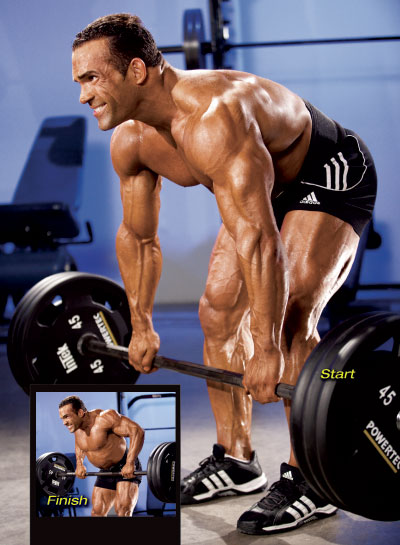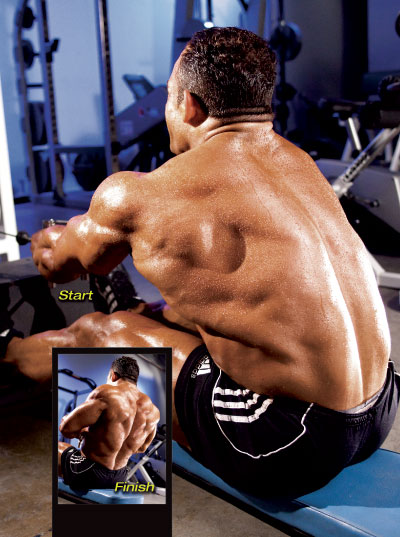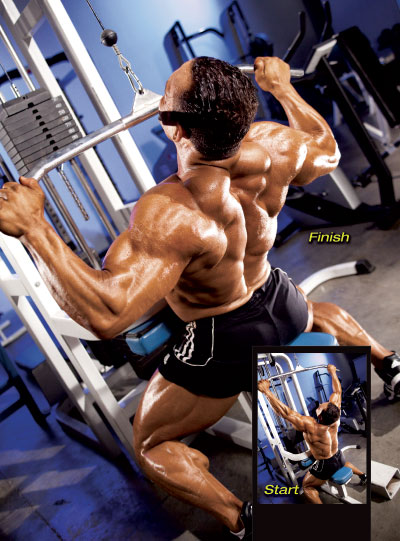Abbas Khatami, one of the top NPC superheavyweights competing today, knows that there’s more than one way to blow up a bodypart. Over the years Abbas has put in a lot of work building his back—to the point where it’s now one of the bodyparts for which he’s known. In the past his focus was on lifting heavy weights. Now he’s into pumping more blood into the muscle. The result—a back that’s wide, thick and detailed—has helped bring him two superheavyweight titles at the IFBB North American Championships, in 2004 and ’09.

What’s his secret to triggering explosive growth in this notoriously hard-to-hit bodypart? A talk with Abbas about back training highlights a handful of areas—rules, if you will—in which a little thought and planning can help you ignite some training dynamite of your own.

Rule 1: Know What Works
Let’s take a look at Abbas’ back workout. He starts with two warmup sets of pulldowns to the front; then come the work sets:
Pulldowns to the front 3 x 10-12
Seated machine rows 3 x 10-12
Bent-over dumbbell rows 3 x 10-12
Seated incline cable rows (neutral grip) 3 x 10-12
Parallel-grip pulldowns 3 x 10-12
Notice anything missing? Abbas doesn’t do deadlifts.
“I never did find that my body responded all that well to deadlifts,” he explained. “It’s not that I don’t like them or don’t want to do deadlifts, but why put forth the effort for something that’s not working?”
That’s a good piece of advice whatever your training level. Don’t do a workout because you feel you have to. Just because walking lunges turned Ronnie Coleman into the ninth wonder of the modern world doesn’t mean they’ll do the same for you. By all means, give them a try—they provide an excellent leg workout—but if you’re not feeling it, move on. The great thing about lifting weights is that there are a million and one options for you to try.
Abbas Khatami’s Current Workout Split
Day 1: Chest, biceps
Day 2: Quads, calves
Day 3: Off
Day 4: Back, triceps
Day 5: Hamstrings, delts

Rule 2: Think About It
As his no-deadlift strategy suggests, Abbas understands his body and how his muscles respond to different lifts.
“I’ve always had a strong mind/muscle connection,” he said. “Being able to see the muscle move in your mind’s eye is critical to success.”
When you’re a beginner, the propensity is to rush into the gym and start blasting out sets hurly-burly, without any sort of a plan. I can’t tell you how many times I’ve seen guys with brand-new training gear, sparkling white tennis shoes and a log book with the price tag still on it throwing around weights at breakneck speed and grunting like an elephant with a sinus condition.
Slow down, especially when you’re just starting out. One of the things that Abbas stresses to all of his training clients is the importance of understanding how it feels to exercise with proper form.
“Especially when training back, form is key,” he advised. “Having a straight back, a neutral neck position and keeping your base under you are vitally important.”
As someone who has had a lower-back injury, I can assure you that failing to heed his advice can have painful consequences.

Rule 3: Know Your Goal
While it’s true that Abbas now considers his back to be among his stronger bodyparts, it wasn’t always the case. As a matter of fact, when he first started out, Abbas thought his back had width but no thickness. His response was a routine designed to make it thicker.
Now that his back is well developed, his training is geared toward hitting it from all angles to maintain balance. Maybe you need back thickness? Back width? Detail? Know what your goal is and adapt your training to make it happen—and don’t be afraid to try something new or unorthodox. The only limits that are currently holding you back are your imagination and, possibly, your marriage to traditional bodybuilding dogma.
Rule 4: Leave Nothing Out
A running theme when Abbas talks about back training is the importance of paying attention to details. “At this point, for me, back training is about little things,” he said. “Where 99 percent of people fail is not in the big things but in executing the little details.” For Abbas those details primarily involve muscle tie-ins and the cuts between back muscles. For you and me they might be more along the line of taking in enough lean protein or getting in enough cardio on a consistent basis—or even lifting enough weight to ensure the muscle damage-and-repair cycle is activated.
Details that can affect bodybuilding progress may be unrelated to your training and nutrition efforts. Stress, for example, causes the body to produce cortisol, that most catabolic of hormones. Ask yourself this: “Is there anything I’m leaving unaddressed that could be hindering my muscle growth?” If an honest assessment says yes, then take care of it.
Rule 5: Take a Long View
Toward the end of my conversation with Abbas, I asked a question I’ve submitted to dozens of competitive bodybuilders: “What’s your goal for the next year?” Typically, I get some boilerplate about “looking to improve” and “coming in at my all-time best.” Abbas’ answer was different for two reasons: It reveals a lot about his lifting philosophy, and it follows success-psychology principles.
“I plan to compete in and win my weight class at the IFBB North American Championships. From there I’d like to compete in my first pro show soon after and then make my Olympia debut.”
It was an inspiring, eyebrow-raising answer from a competitor who’s been knocking on the door of the pro ranks for a while. If you think he’s being cocky, ask yourself this: Why shouldn’t Abbas feel that he’s going to succeed? With that simple two-sentence answer he reinforced his confidence in himself and in the time and effort he’s spent building a championship-level physique, including his spectacular back.
Editor’s note: Abbas Khatami is an NPC national-level bodybuilder and personal trainer. Write to him at http://musclewebsites.com/clients/abbas/index2.htm. IM
















You must be logged in to post a comment Login